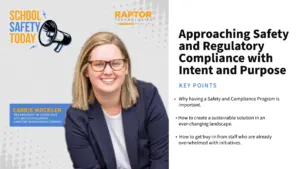Here at Pepperdine University, we were already planning an upgrade and needed to make sure our latest deployment factored in the possibility of all learning models – in-person, hybrid, and online– given the uncertainty of the upcoming academic year.
We needed a solution that was easy to operate, could provide faculty with engaging learning environments, and could accommodate any combination of synchronous and asynchronous learning. In the end, we decided to implement ClearTech’s EduFLEX solution with Panasonic’s AW-HE38H Pan/Tilt/Zoom (PTZ) cameras for their simple installation and maintenance, ease-of-use, and compatibility with our existing AV equipment.
Overall, the research and deployment process gave us some important insights into how we will need to think about AV upgrade plans for the coming years.
Adhering to a wide range of faculty input
We found it was critical to begin our research process by seeking input from the faculty who would be using the technology on a daily basis. Because faculty typically teach in different classrooms, we needed to make sure the technology was consistent from room to room, allowing for easy set-up and minimal technical disruptions to the student learning experience.
Thus, we knew we needed a solution that could be easily deployed across the majority of our campus – upwards of 160 classrooms.
Similarly, faculty echoed the importance of learning how to operate one solution that could easily transition from online instruction to a hybrid model and vice versa. As you can imagine, depending on the academic discipline, faculty tend to vary in terms of their teaching styles. While a mathematics professor may adopt more of a lecture method, mapping out problems on the board for students, an English professor may rely more on facilitating an engaging classroom discussion to stimulate students. Many professors wanted to be able to operate as if all students were seated directly in front of them. Thus, we needed a solution that would allow faculty to move around the room and create seamless and engaging learning experiences for students.
Delivering an engaging student experience from afar
Deploying the right mix of technology can be the difference-maker in replicating the in-person learning experience remotely and helping students feel connected and engaged. Hardware and software should complement each other for a seamless experience for both faculty and students.
We’ve found that it really comes down to ease of use – after professors have had to modify their lesson plans and students have adjusted to new modes of learning, technology should not pose another barrier to engaging learning experiences. In fact, technology should provide a connection point between those groups and video is key to that.
PTZ cameras pose a variety of benefits for distance learning. When employing these cameras, professors don’t need to be confined to one spot with a low-res computer camera. Instead they can move freely around the room, capitalizing on the camera’s wide field of view and optical zoom lenses to replicate the engaging in-person experience for students at home. Additionally, the cameras have the ability to easily zoom in and out on the board, so students will always have a clear image of what the professor is presenting.
The overall experience is more dynamic and similar to what students would receive in the classroom because the view can toggle between professor, whiteboard, and other elements in the room.
Looking ahead
In advance of the fall semester, we installed the new PTZ cameras in a total of 166 classrooms: 74 undergraduate rooms and 92 graduate facilities. This semester, all classes are employing a distance learning model, but faculty can come to campus and use the classroom to deliver their lessons. So far, we have received positive feedback from faculty in terms of their ability to create engaging learning environments with the solution.
Ultimately, this process of researching and deploying distance learning technology underscored the significance of seeking faculty input and prioritizing solutions that could best replicate the engaging in-person experience for students.
Here at Pepperdine, we put classrooms on a five-year refresh cycle for AV upgrades and for the foreseeable future our upgrades will need to consider the possibility of distance and hybrid learning models.
Overall, in order to provide an optimal learning environment for students and faculty, we need to make virtual learning feel as connected as being physically present in the classroom. That’s where the right technology becomes key for helping faculty seamlessly engage students and create a collaborative learning atmosphere.
Follow us on social media for the latest updates in B2B!
Twitter – @MarketScale
Facebook – facebook.com/marketscale
LinkedIn – linkedin.com/company/marketscale







